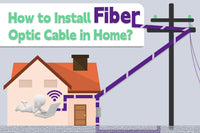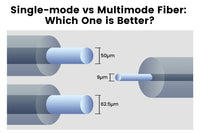Fiber optic cables are known for their high-speed data transmission over long distances. However, due to their fragility, it is necessary to consider the fiber optic bend radius during fiber optic cable installation. Understanding the minimum fiber optic bend radius is crucial to ensure cable performance and reduce errors. What is bend radius and why does it matter? Read on to find the answer.
Bend Radius of Fiber Optic Cables
It is hard to avoid bending the fiber optic cable during the installation, but you should not overbend your cables. Overbending may cause light refraction and affect data transmission. In general, the more acute angle you bend your fiber optic cable, the increasing amount of light will leak. This concept is known as bend radius, generally defined as the minimum radius at which a fiber optic cable can be bent without cable damage and performance degradation. The tighter the bend, the smaller the radius. And the smaller the radius is, the more flexible the cable is. The minimum bend radius varies from different fiber optic cables.
(Note: Bend radius is divided into two types: macrobends and microbends. Macrobends can be seen by human eyes, while microbends are the small microscopic bends in the fiber, usually measured in millimeters.)

What Will Impact Bend Radius?
The bend radius of fiber optic cables can be affected by many factors and here we list 3 of them.
- Cable Construction: The construction of fiber optic cable plays an important role in determining cable bend radius. For example, the cable with a thicker jacket usually has a larger bend radius and tight-buffered cable has a smaller radius.
- Core Diameter: Fiber optic cables come in different core diameters. For example, single mode fiber has a smaller core than the multimode fiber, making the single-mode fiber optic cables more resistant to bending.
- Cladding Material: Different cable cladding materials can affect the bend radius of fiber optic cables. Amore flexible cladding usually means a smaller bend radius.
How to Calculate Bend Radius of Fiber Optic Cables?
Now that you know the bend radius of fiber optic cables can be affected by many factors, including the cable material, core diameter, fiber types, and pulling tension. Generally, the manufacturers of fiber optic cables will provide the bend radius in the cable specification. But here is a simple formula to calculate bend radius:
Bend radius = Cable Outer Diameter x Cable Multiplier
Cable Outer Diameter: Different fiber optic cables have different outer diameters.
Cable Multiplier: The multiplier is usually determined by the industry standard and cable type.
Bend Insensitive Fiber Optic Cable
Optical fibers are sensitive to bend and stress. Once the fiber is overbent, high light loss can occur in the stressed part of the fiber. Bend insensitive optic fiber cables are designed to solve this problem. The insensitive fiber works by adding a layer of glass around the core that has a lower refraction, allowing lost light to be reflected back into the core. These cables provide a solution to fiber installation in some specific environments where tight bend and cable flexibility are essential, especially in tight areas.

Types of Bend Insensitive Optical Fibers
Bend insensitive optical fibers are divided into two common types: Bend Insensitive Single Mode Fiber (BISMF) and Bend Insensitive Multimode Fiber (BIMMF).
BISMF only allows one type of light mode to pass through at a time. The International Telecommunication Union (ITU) has specified BISMF as two types: G.657.A and G.657.B. Among these classes of fibers, the G.657.B2 version can achieve a bend radius of 5 mm.
BIMMF supports multiple modes of light to propagate through it. The minimum bend radius is 7.5mm. BIMMF cables are often used in data centers and server rooms.
Advantages of Bend Insensitive Optical Fibers
- Flexible installation: The bend insensitive optic fiber is suitable for installation on walls, pillars, tubes, ceilings, and other uneven places because the small bend radius makes it flexible enough to withstand a large-degree bend around the floors, walls, or doors without much light loss.
- High performance: The bend insensitive optic fiber causes low data degradation even when it is overbent. It is ideal for high-density applications where cables need to be installed through crowded conduits.
- Cost-effectiveness: The cost of installing bend insensitive fiber optic cables is not much higher than the standard fiber optic cables. The ability to withstand tighter bend can also help reduce maintenance costs.
- Same splicing method:It can be spliced using the same way as standard fiber optic cables, ensuring convenience and ease of use.

Do’s and Don’ts to Protect Fiber Optic Cables
If you are going to deploy fiber optic cables, you’d better follow these installation guidelines to protect fiber optic cables.
Do’s
- Try to complete the installation in one pull rather than repeating pulls on cables.
- Drop the cable vertically down rather than pulling it up.
- Keep cable ties tightened to be snug but loose enough to be moved.
- Lay the cable in the figure-eight pattern to prevent twists and tangles.
Don’ts
- Do not exceed the maximum pulling tension rating.
- Avoid twisting the cable as it will produce stress on the fibers.
- Do not overbend the fiber optic cable beyond its minimum bend radius, as it can cause damage to the cable.
Conclusion
It is unavoidable to bend fiber optic cable during cable installation, management, or maintenance. Overbending can cause cable cracks, increased signal loss, and data distortion. Understanding bend radius is critical when you deploy the fiber optic cable. If you need to install fiber optic cables in applications that require tight bend, bend-insensitive fiber may be your prior option.
FAQs
Will the bend radius of fiber optic cable change?
The minimum bend radius may be affected by external factors, such as temperature and mechanical stress.
How to maintain proper bend radius during fiber optic cable installation?
Conform to the installation techniques and guidelines or hire the technician to help you install cables to avoid overbending.
Is bend insensitive fiber compatible with regular fiber?
Bend insensitive fiber is compatible with single mode fibers because there is only one light mode and the trench only has minimal impact. But its compatibility with multimode fibers needs to be proved.
For more information on this topic, you can keep up on our blogs. While VCELINK offers general and basic information for our customers and other visitors to the website, it’s not professional advice.



Be the first one to comment.
Leave a comment